by Winding Pathways | May 7, 2020 | (Sub)Urban Homesteading, Garden/Yard, Nature
What’s to Love About a Prairie?
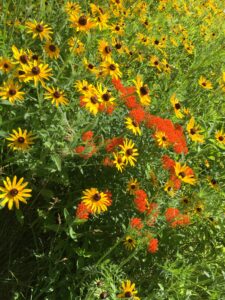
prairie forbs help pollinators
We love prairie. Prairie is color. Flowers yellow, red, blue, and every hue in between shine through tall grasses. Prairie beckons flying flowers……butterflies as well as birds, bunnies, and other interesting animals. Compared to a groomed July lawn, prairies are a joy to our eyes as grasses and flowers wave in the evening breeze.
When we moved to Winding Pathways in 2010, we inherited lawn. Lots of lawn. Starting almost immediately we transformed two big sections into a prairie. But we still had lots of lawn left. So, in late 2019 we decided to whittle it down by about another 3,000 square feet. In-place would be a short profile prairie sporting at least 70 species of wildflowers.
Lawns Have Their Purpose
We’re not anti-lawn. They are great places to relax with friends and play. There’s just too much lawn in America and its environmental impact is huge. Lawn watering annually consumes 3 trillion gallons of irrigation water, 200 million gallons of gas for mowing, and 70 million pounds of pesticides. There’s no need for that.
Ways to Ecologically Manage Lawns
- Allow diverse plants to grow.
- Avoid watering or spraying.
- Mow on a high setting. We use a battery-powered EGO mower that’s recharged by our solar electric panels.
There are lots of ways to establish a prairie. None is perfect. Some yield fairly quick results, while other methods require patience. Through a series of blogs this year we will detail how we decided to plant prairie, explain its benefits, and detail a way to achieve fairly fast results. Ours is just a model of one way to do it. We encourage anyone who has a lawn to consider transforming it into prairie or other native vegetation even if it’s only a few square feet.
Why We Are Doing It: Decision…
There are lots of reasons for converting a lawn to a prairie. Here are a few of ours:
- We’re individualists. We find neighborhoods with rows of perfectly clipped, fertilized, and sprayed lawns boring.
- We thrive on diversity. Every new bird, plant, and animal discovered in our yard is a thrill. Ecologists who have long said that diversity implies stability, are correct. Species change from year to year but always there’s change within the stability of a healthy habitat – our prairie.
- We consider mowing a waste of time and resources. Nationally, lawn mowing consumes millions of gallons of gas. Mowers spew out emissions that foul the air and contribute to climate change. Mowing is time-consuming.
- With a few exceptions, we shun chemicals. We’ve never used any insecticides and only use a few herbicides to help our prairie compete with persistent introduced plants.
- It’s all about beauty. As we sit on our summer porch colors dance in the wind from hundreds of blooming plants and butterflies hopscotch about. Prairie is a joy to the eye.
- Water is precious. Perhaps the world’s most precious resource is clean water. Deep-rooted prairie, unlike lawns, never needs irrigation. Instead, it filters, cleanses, and sequesters rain that percolates down to the water table through zillions of interlocking roots.
- Years ago, we restored one prairie. But on the other side of the drive is a swath of lawn that continually needed mowing. Worse yet, it was on a slope, causing our creaking knees to work extra hard pushing the mower upslope. So, in late 2019 we decided to convert part of it to a prairie, leaving a margin of a mowed lawn around it.
…and Early Preparation
So, we began to plan our newest prairie. Unlike the existing ones we wanted it to establish as quickly as possible and we wanted great plant diversity and lots of color with only one exception. We wanted a short-grass/forb prairie, so chose the seeds carefully. We chose not to include Big Bluestem, Switch, and Indian Grasses in our mix.
We also had to determine these things:
- Was it legal in our area? Yup. We checked ordinances.
- Would it bother the neighbors? No. We informed them and learned they were fine with it.
- Did we have the time and money to establish and maintain it? Yup. We are frugal and energetic enough to maintain and nourish the prairie.
Just What Is Prairie?
Native prairie is an enormously complex and beautiful grassland that became established in the American middle after the glaciers receded and the climate warmed and dried. It stretched from Ohio to the Rocky Mountains. Eastern prairies lived where rainfall and humidity were fairly high. It was nearly plowed to extinction and was replaced by vast corn and soybean fields. Shortgrass prairie can be just ankle high and lives in the dry Great Plains with the mid-grass prairie in between. We live in the area once occupied by tallgrass prairie, a truly endangered ecosystem. Establishing prairie is appropriate in areas that were once prairie and it is ecologically wonderful to replace lawns with vegetation native to the site.
Winding Pathways is partnering the project with the Monarch Research Project, Linn County Roadsides, Sustainable Landscape Solutions, and Pheasants Forever.
Now on to the next phases of our Prairie Renaissance. (For earlier background on pollinator patches read our blog of February 20, 2020.)
-
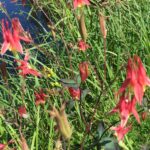
-
Columbine blooms early in the season
-
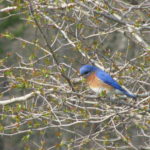
-
Bluebirds hang out on branches.
-
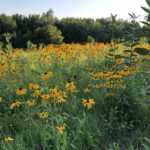
-
Blackeyed Susans populate a prairie.
-
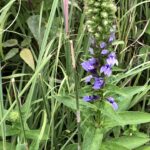
-
Blue lobelia is one of the more demure forbs that attract pollinators.
-
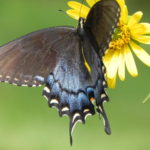
-
Black Swallowtail butterfly on cup plant.
-
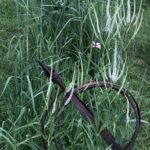
-
Culver’s Root sends up white candles of blooms.
-
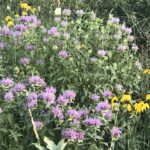
-
High summer flowers like monarda and yellow coneflower attract butterflies
-
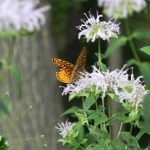
-
Summer is the time to attract and enjoy butterflies.
-
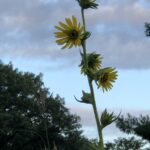
-
Compass plant is among the late summer forbs.
by Winding Pathways | Apr 16, 2020 | (Sub)Urban Homesteading, Garden/Yard, Nature, Pests
Lyme Disease is something you just don’t want. Rich has had it twice. It was no fun, and he was lucky. Nearly as soon as symptoms appeared, he visited our family physician. She prescribed a powerful antibiotic that worked wonders and left him with no lingering problems. Unfortunately, many Lyme Disease victims suffer pain and fatigue for years. It’s serious.
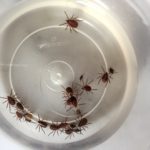
Collection of ticks
Lyme is often transmitted to a human from a bite by a tiny tick that picked up the disease bacteria from an infected white-footed mouse. It once was thought that deer were the primary carrier but mostly they are host to a tiny larval tick that infects a mouse that allows another tick to infect a person.
In theory, eliminating white-footed mice from a yard and home will greatly reduce the odds of transmission of this disease to people. Killing all of them isn’t feasible but reducing their numbers is.
About White-Footed and Deer Mice
White Footed and Deer Mice are amazingly common across much of North America. They’re the cute, native mouse, not to be confused with the common house mouse that originated in the Old World.
White Footeds naturally live in dry temperate forests with brush. That perfectly describes suburban landscaping. It’s likely that five to 20 white-footed mice live in close proximity to most suburban families. They’re nocturnal and rarely seen.
Here are some characteristics:
- They’re hoarders. Find a cache of corn, dog food, or acorns in a shoe or empty can and you’ve found a white-footed mouse cache.
- They reproduce like crazy. A 44-day old female can become pregnant and bear a litter after 22 to 28 days. Babies become independent in three weeks and soon begin having their own babies. Mom often has two to four litters a year.
- They don’t live long. A year-old mouse is elderly.
- Foxes, weasels, hawks, owls, coyotes, and many other predators love dining on mice.
- White Footed mice enjoy coming into homes, where they often find food and enjoy a furnace’s warmth. They can bring with them disease-bearing ticks.
Prudent homeowners carefully manage ticks, in part by reducing white-footed mice numbers. The fewer mice that live near people the lower the odds a person will contract Lyme Disease. So, managing mice and ticks makes for a healthier home and yard. Here are a few tips:
To reduce mouse populations and entry to homes:
- Welcome mouse predators. Karla Bloem, Executive Director of the International Owl Center says, “Two actions people can take to encourage owls are to protect large dead trees that aren’t a threat to people of buildings should they fall. Owls love them. Also, building and erecting an owl house can welcome owls to live near a home and catch and eat mice.” Barred owl nest box plans, and plans for many other birdhouses, can be found at www.nestwatch.org.
- Plug up holes that allow mice to enter a home and replace worn or broken weatherstripping. This is an important fall maintenance that also keeps cold drafts outside and reduces heating bills.
- Avoid feeding mice. They love dining on dog or cat food left in a dish overnight or birdseed left under a feeder. Only feed pets and wild birds what they can eat in a short time. Then, pick up and clean the pet bowl.
- Use snap traps to kill mice in the house. Avoid poison. A poisoned mouse can stagger outside to be caught and eaten by an owl, which can sicken or die from the poison.
A Few More Ways to Reduce Lyme Disease
In addition to reducing mouse numbers and applying a vaccine to keep survivors free of Lyme Disease bacteria here are a few other ways a person can do to reduce odds of infection:

Pants, boots, gaiters and insect repellents help protect from ticks.
Use Permethrin: When applied to clothing, not skin, this chemical repels and kills ticks. Rich purchased several sets of clothing from the Insect Shield Company that are impregnated with permethrin. Supposedly the tick-killing effectiveness lasts for 70 washings. The chemical is also available in spray cans to apply to any clothing.
Do Tick Checks: After being outside, strip down and check the body over for ticks. Then take a hot sudsy shower. Ticks usually crawl around on a person for several hours before biting. A tick merely walking on the skin can’t infect a person.
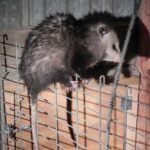
Opossums groom themselves carefully.
Thank and welcome opossums: New research indicates that opossums are tick vacuum cleaners. Ticks climb on them, but these primitive mammals groom often and eat the ticks they remove from their fur and skin. If you have a possum living in the yard be happy.
An Emerging Tool in the Battle Against Lyme Disease
A new product is being developed and tested by a major research company. It is an oral nontoxic vaccine placed in small baits. When strategically positioned around a yard, mice not yet infected with Lyme bacteria eat it and become resistant to the bacteria. Mice uninfected by Lyme can’t spread the disease to a person. If all goes well this product will be on the market by 2021 and may be a major help in reducing human cases of Lyme Disease.
Lyme Disease is an awful condition. Taking precautions to reduce the odds of being infected makes sense.
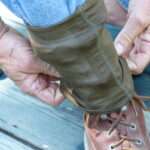
gaiters with tick guard help repel ticks.
by Winding Pathways | Apr 9, 2020 | (Sub)Urban Homesteading, Energy Efficiency
Sunshine On Our Shoulders, Makes Us Happy!
We love John Denver’s famous Sunshine song almost as much as we appreciate sunshine! After a long gloomy winter, the sun finally appeared toward the end of March. We welcomed it into our home and went outside to soak it up.
Although 93 million miles away, the sun constantly sends cheery energy to earth. Without it life couldn’t exist, so we celebrate the sun. Here are some sunny things to be thankful for:
It’s a Vitamin D engine. Sitting in the sunshine helps our body beef up its Vitamin D. This means strong bones for us! And Vitamin D boosts our immune system so we fight infections more easily.
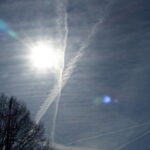
Sunshine benefits us in many ways.
It brightens our house. We are amazed at how many people keep their blinds closed, even in the winter, when they could open them and let natural light warm both the human soul and interior temperature. Sunshine can significantly reduce heating and lighting utility bills, and our nearest star never sends a bill!
It energizes plants. In early April we planted radishes and lettuce in a cold frame on the south side of our home. Sunshine warms those tiny seeds and fuels the miraculous process of photosynthesis that enables plants to grow. Soon we’ll be eating spring greens and enjoying the snappy taste of fresh radishes.
It is one of the best sanitizers. Sunshine can kill bacteria and some viruses. So, we sometimes leave things we want to sanitize in the sunshine before bringing them into the house.
But mostly we savor the way early spring sunshine brightens our mood as it stimulates the winter dormant world into glorious life.
by Winding Pathways | Apr 2, 2020 | (Sub)Urban Homesteading, Foraging, Garden/Yard
Our Yards Offer Nutrition
Every spring we look forward to eating delicious, free, wild greens that grow in our yard and just about every place people live. Having an ability to identify, pick, prepare, and eat wild foods gives us some comfort in this age of uncertainty.
We encourage everyone to boost their backyard food production through gardening, backyard chickens for those who can keep them, and foraging. Here are a few things to consider before picking and eating any wild plant.
- Make sure you’ve identified the plant correctly. Use two sources to confirm identification. These might be an expert forager and a book or Internet source or a combination.
- Make sure the plants have not been contaminated by pesticides, animal feces, or vehicle exhaust. It’s best to forage away from busy roads. Wash plants thoroughly before preparing.
- Eat just a small portion the first time. Although it might be fine food for most people there’s a chance you might be allergic to it.
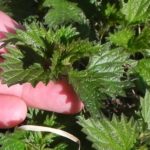
Carefully pluck the top three leaves off.
The key to enjoying all wild greens is to harvest them when they are very young. Many edible wild plants are tender and delicious shortly after they sprout but soon get coarse and bitter as warm weather stimulates their growth.
Nettles, sometimes called stinging nettles, live in moist places near streams, ponds, and woods, where they seem to prefer light shade. We have a couple of patches in our yard. They green up early in the spring, and we pick them before they are ten inches tall. We carefully pick just the top three or four small leaves. Remember these are stinging nettles. Wear light gloves or carefully pinch the top growth off the plant between the thumb and index finger. About a hundred leaf clusters make a great dish for the two of us. Rinse the nettles and boil them for a few minutes. The stinging part is a protein that dissolves in boiling water. We put a dab of butter on the drained cooked nettles and drink the water as a delicious spring tea.
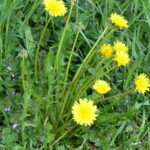
By mid-summer dandelion leaves are tough and bitter.
Because of herbicide companies’ promotions, just about everyone dislikes dandelions. Some have heard that dandelions are edible. It is true and, we need to thank our European ancestors for bringing dandelions to the New World. Otherwise, they might not have survived. They are high in vitamin A, folate, vitamin K, and vitamin C and a good source of calcium and potassium. Today, folks from Mediterranean countries grow and harvest dandelions as crops. They are a popular dish in Italian communities.
The few people who have tried eating them make the mistake of picking mature leaves in mid-summer. By that time, they are bitter and inedible. The best dandelion leaves are those picked in early spring and have been under a blanket of leaves. They’ll be partially blanched and delicious. It’s fine to pick small young leaves that can be added to salads if they are not too bitter. If they are bitter, boil two pots of water. Put the leaves in one pot and boil for a couple of minutes. Drain and put them in the second pot of boiling water and boil for another minute or so. The boiling removes the bitterness. Drain and enjoy with butter and salt and pepper.
This is a year of great anxiety and having some knowledge of how to find free food nearby can remove some of that concern.
by Winding Pathways | Mar 26, 2020 | (Sub)Urban Homesteading, Birds, Nature
*Note: Our assessment of WindowAlert is based on our experiences both from purchasing the company’s product and a complimentary set of decals to try.
Last fall as Rich was walking along the outside of the Cedar Rapids Public Library and found a tiny dead warbler on the sidewalk beneath a large window. Fall warblers are tough to identify but it was a blackpoll. Why did the bird hit the window?
This amazing bird has an enormous migration from the far north of the continent to the south each fall, with a reverse trip in the spring. The bird Rich found probably was only halfway through its autumnal journey. Its death was sad and probably could have been prevented.
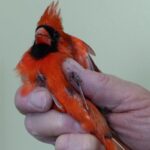
Cardinal
Occasionally we have a bird crash against our windows at Winding Pathways, and a male cardinal persists in cracking his head against a window at our church in Cedar Rapids.
Bird numbers are declining at an alarming rate for many reasons. Certainly, habitat loss and climate change are taking a toll. Feral cats and windows also kill millions of birds every year. Some of that loss can be prevented.
Why Birds Are Killed by Windows?
According to Spencer Schock at WindowAlert, birds are impacted by windows for two reasons. First, all year, but especially during migration, birds simply don’t see the glass and assume they can fly right through it. That’s what happened to the warbler. Second, it’s springtime rivalry. The cardinal banging on the church window sees his reflection, assumes it is a rival and tries to chase it off or intimidate it. This behavior is common, especially among cardinals, and usually happens from late winter into early spring. It’s rarely fatal to the bird but can annoy humans inside the building.
How to Reduce Bird Strikes on Windows.
The simple solution for both types of bird strikes is to do something so the animal recognizes it is glass. Here are some ways to reduce window strikes:
- Close Drapes. But then people can’t see out and sunshine can’t enter.
- Put something over the exterior window that looks to birds like a barrier or physically keeps them away. Draping the mesh netlike material made to protect cherry trees from birds trying to steal fruit works. The downside is that sometimes birds get tangled in it.
- Put decals on the windows to help birds identify a glass barrier. We like the many designs sold by WindowAlert. They’re easy to apply, attractive, inexpensive and work well.
- Eliminate reflection to keep cardinals and other territorial birds from attacking their own image. WindowAlert has a material called Stop Bird Attack. It comes in a spray can that’s sprayed on the outside of the window. The material looks like white flocking put on Christmas trees to imitate snow. It eliminates reflection and can be easily cleaned off the window after the mating season.
-
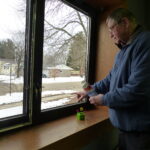
-
Check the windows first.
-
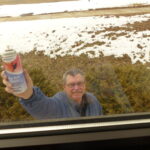
-
Ready to spray
-
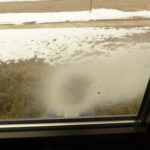
-
The spray makes the window opaque.
-
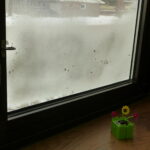
-
The BirdStop spray resembles Christmas tree flocking.
What to Do When a Bird is Found under a Window
A few times we’ve been sitting in our home and hear a bang as a bird strikes a window. We sadly find the poor animal lying still under the window. There are two likely outcomes.
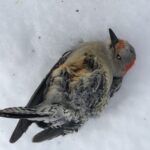
This bird broke its neck hitting a window.
The bird is either dead or dying and there’s nothing we can do to alter that unhappy outcome. e bury the poor creature and add more visibility items to the window.
The bird has been stunned and will soon recover and fly away. Often a bird will recover, but while it is stunned it’s vulnerable to cats and other predators. Spencer advises gently putting the bird in a closed cardboard box or large paper bag. As soon as it has recovered, release it outdoors.
Probably the best thing a homeowner can do to help songbirds is to plant a diversity of native grasses, flowers, shrubs, and trees to create habitat. The next best action is to keep cats indoors and reduce the odds of collisions with glass using the methods described above.
by Winding Pathways | Mar 19, 2020 | (Sub)Urban Homesteading, Garden/Yard, Nature
Stuck at home? A tiny microbe is sure changing the lives of people worldwide. Unexpectedly, meetings and schools have closed and transportation is disrupted as uncertainty runs rampant. With every challenge comes an opportunity. We’re sticking close to home at Winding Pathways but are using more time around the house to do fun things and accomplish projects ignored during normally busy lives.
In the midst of uncertainty, it’s easy to be overwhelmed by events and suffer from lethargy and fatigue. That comes with the turf. So, being physically and intellectually active helps ward off melancholy.
With millions of kids now home with parents and other workers and retired folks staying closer to home and in apartments, here are a few productive activities we suggest. Anyone anywhere can engage in at least some of these activities. And, Winding Pathways invites you to create your own generative ideas to boost your immune system and help us all through this challenging time.
Attune to and with nature.
- Research affirms that contact with nature is calming and healing. Shinrin yoku also known as “forest bathing” is a way to connect with calming elements in nature. This concept extends far beyond the literal interpretation of a forest. Any natural area of any size can provide healing benefits. John Muir wrote it well:
“Climb the mountains and get their good tidings. Nature’s peace will flow into you as sunshine flows into trees. The winds will blow their own freshness into you, and the storms their energy, while cares will drop away from you like the leaves of Autumn.”
By connecting with nature wherever we are, we can learn and have a good time, too.
-
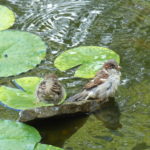
A water source helps attract birds.
Birding: Even in the biggest cities birds abound. Sparrows and pigeons are fascinating. Look closely at a group of birds hanging around the balcony or out the back door and soon you will note individual differences. Size. Shape. Behaviors. One sparrow, for example, may have an unusually colored feather while another has a twisted beak. Once you can identify individual birds, it’s possible to conduct simple research. Do the birds seem to hang out with their friends?
If odd feathered sparrow #1 seems to like being with crooked beak sparrow #2 maybe they are friends……or perhaps mates. How many different species of birds come to the Balcony or yard? You might be surprised. Look up. Spring is migration season and millions of big birds are heading north. Often their route takes them even over big cities. They often fly high so look with “soft eyes” for undulating strings of birds aloft.
Experiment. Put a birdseed mix in a feeder or even on a backyard table or the ground. What seeds do birds prefer?
- When the virus appeared, plants remained in winter mode across much of the country, but spring is fast approaching in the northern hemisphere. Now is a great time to keep a journal, or a simple list of the order in which buds swell and leaves emerge.
Gardening
-
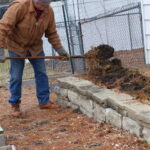
Work the garden to connect with the earth.
Gardening is a great remedy for stress, and it can yield a surprising amount of food, even in a tiny space. One of the best vegetables for kids to plant is the humble radish. These cold, hardy, spicy roots can be planted very early in the spring and often harvest comes in just a few weeks. Lettuce, chard, spinach, and other greens also can be planted early, but beans, tomatoes, corn, okra, squash, and many other veggies need to wait until winter’s frost is just a memory.
Take a walk
- Nature is pretty safe from Coronavirus. It doesn’t lurk in the woods. Poke around the yard. And, a ramble in a nearby park, woods, or along a trail is a stellar way to spend a few hours.
- Another option is to find a labyrinth outside to walk. The World Labyrinth Locator lists labyrinths across the world. A labyrinth is different from a maze. Labyrinths are designed to help people center, release what is on their mind or in their heart, receive inspiration, and reunite with their community in a positive way.
Connect Virtually
- Isolation isn’t fun. Call friends. A phone call is a great way to cheer a friend. And, check in with neighbors you rarely see. Think of ways to direct the conversation to the positive. Live the positive through regular practice. What does this do? Read below.
Practice Mindfulness
-
- Mindfulness is the ability to be present and aware of our thoughts with curiosity and kindness. Jon Kabat-Zinn provides excellent guidance on this. We practice this with adult students at Kirkwood Community College. To a person, they find benefit in reducing blood pressure, anxiety and heart rate, while their sense of calm increases.
- Another form is HeartMath which helps people focus first on breathing, then on creating a peaceful place in their mind that they feel in their heart and can return to anytime when under stress.
- Reduce time on social media and listening to reports on radio or television. Keep abreast as needed and avoid perseverating on the negative.
- Think and behave positively. Norman Vincent Pearle was a master at helping us shift into the positive.
- Laugh! Laughter releases positive hormones and neurotransmitters. An easy way to remember this is to give yourself a good DOSE of levity and positivity. Dopamine, Oxytocin, Serotonin, and Endorphins. These counteract the stress hormones. How can we do this? Read jokes, watch funny films or old TV shows that make you laugh.
-
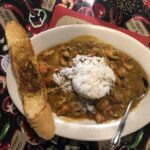
Healthy foods are important in this time of stress.
Eat Healthily. When we are under stress, we tend to eat more and the wrong foods. So, mind what you eat, drink water, and try some of these activities above and add your own.
-

Reading positive literature will help us.
Read Entertaining Materials. From Comic books to graphic novels to non-fiction, engage your brain, learn and go lightly through this time. Share an engaging article, book, poem or song with someone. Recently The Gazette featured a woman, Mary Fannie Woodruff, from Virginia who continues to bake pies at 103 years old! How cool is that? The article was a great read we shared with family in Virginia.
We have many ways that we can all move through this uncertain time and help each other out on this winding path of life.



























